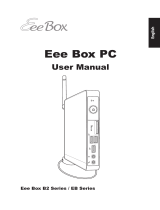
ノートパソコン ユーザーマニュアル
5
Chapter 5: FAQとヒント
安全に使用するためのヒント ..............................................................80
ハードウェアに関するFAQ ...................................................................81
ソフトウェアに関するFAQ ...................................................................84
Chapter 6: 付録
光学ドライブ情報 (特定モデルのみ) .................................................88
内蔵モデムの適応規格 (規格/プロトコルなど原文掲載) .........91
Overview ......................................................................................................91
Network Compatibility Declaration ..................................................91
Network Compatibility Declaration .................................................92
Non-Voice Equipment ...........................................................................92
Federal Communications Commission Statement .....................94
FCC Radio Frequency (RF) Exposure Caution Statement .........96
Declaration of Conformity (R&TTE directive 1999/5/EC) ..........96
CE Marking ..................................................................................................97
IC Radiation Exposure Statement for Canada ...............................97
Déclaration d’Industrie Canada relative à l’exposition aux ondes radio .....98
Wireless Operation Channel for Dierent Domains ...................99
France Restricted Wireless Frequency Bands ................................99
UL Safety Notices ................................................................................... 101
Power Safety Requirement ................................................................ 102
TV Tuner Notices .................................................................................... 102
REACH ........................................................................................................ 102
Nordic Lithium Cautions (for lithium-ion batteries) ................ 102
Optical Drive Safety Information ..................................................... 104
Macrovision Corporation Product Notice .................................... 104
CTR 21 Approval (for Notebook PC with built-in Modem) .... 105
ENERGY STAR complied product ..................................................... 106
European Union Eco-label ................................................................. 107
Prevention of Hearing Loss ................................................................ 107
Regional notice for Singapore .......................................................... 107
Global Environmental Regulation Compliance and Declaration .... 108
回収とリサイクルについて ................................................................ 108
筐体のコーティングについて ........................................................... 108




















